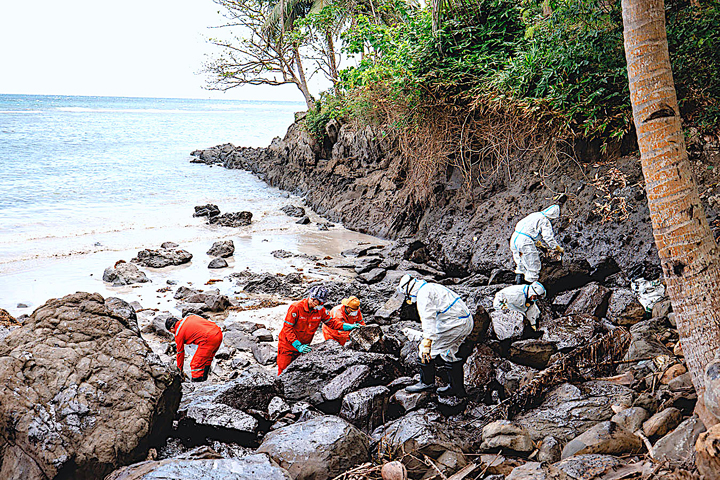A faith-based coalition that seeks to protect the Verde Island Passage (VIP) is calling for accountability and deeper look into the oil spill that wreaked havoc in the waters of Oriental Mindoro.
The Protect VIP campaign network said the incident must serve as an “eye opener” to the neglect the Verde Island Passage has long suffered despite its socioeconomic and ecological significance.
VIP is a strait that separates the islands of Luzon and Mindoro, connecting the South China Sea with the Tayabas and the Sibuyan Sea beyond.
The devastating oil spill occurred after MT Princess Empress capsized on February 28, bringing down 800,000 liters of industrial oil.
“We call on the Philippine government for the most urgent action to contain the spill, assess the severity of damage, and prioritize the welfare of impacted communities who must receive livelihood support and protection from health impacts,” said Fr. Edwin Gariguez, lead convenor of Protect VIP.
“We also demand accountability from the owner of MT Princess Empress, RDC Reield Marines Services and the fuel supply it contains,” he said.
The oil spill has put at risk more than 30 of Oriental Mindoro’s marine-protected areas, and has affected other provinces like Antique in Western Visayas.
The province of Oriental Mindoro has placed at least 76 coastal villages across nine out of its 14 towns have been placed under the state of calamity.
The faith-based group said at least 18,000 fisherfolk in Oriental Mindoro alone have been robbed of their livelihood as fishing activities are put on hold.
Residents, it added, are also robbed of their seafood supply—“a heavy blow for a province in which over 50 percent of households already suffer various levels of food insecurity”.
“We, thus, join local residents in lamenting what would be a prolonged suffering of the local fishing industry—valued at P11.80 billion across the five provinces of VIP in 2021—as impacts of the oil spill are expected to be felt for years to come,” said Gariguez, who is also the former executive secretary of Caritas Philippines, a relief, development and social service organization of the Catholic Bishops’ Conference of the Philippines (CBCP).
He also stressed the need for the government to take into account the bigger picture and what is at stake in the oil spill incident in biodiversity-rich VIP.
The group has been raising alarm on the issue of having more heavy industry development around the VIP area—especially fossil fuel power plants and liquefied natural gas terminals, which would receive shipped cargoes of LNG.
“More plans for LNG terminals means more shipping vessels passing through the marine corridor. This increases the possibility of a similar situation happening in the future,” Gariguez said.
“The Verde Island Passage must be afforded no less than the greatest protection due to a global treasure for marine biodiversity,” Gariguez pointed out.
At the same time, Gariguez said Caritas Philippines would extend assistance to 250 families.
“Caritas Philippines has committed to support 250 affected families with food packs that will be made available to the unreached and most needy affected coastal communities,” Gariguez said in a statement on Thursday.
He added that the Diocesan Social Action Center, which Gariguez heads, and the affected parishes would have a meeting at St. Augustine Parish in the town of Pinamalayan on March 14 to determine the beneficiaries of the assistance.
The Lipa Archdiocesan Social Action Commission and the Center for Energy, Ecology and Development (CEED) will also provide food items and emergency assistance.
“The relief goods will be temporarily stored in the available space in St. Francis of Assisi Quasi Parish for distribution once the beneficiaries’ list has been finalized and operation plan has been set up by next week,” the priest said.
The church is also in contact with the concerned local government units and the provincial government of Oriental Mindoro for continuous response to the needs of the most affected communities.
The towns of Naujan, Pinamalayan, Gloria, Bansud, Bongabong, Roxas, Mansalay and Bulalacao have been placed under a state of calamity due to the damage of the oil spill, and in order to help those concerned the communities affected by the disaster.
A state of calamity was also declared in the town of Caluya, Antique due to the oil spill.
Meanwhile, PresidentMarcos Jr. has ordered the Department of Environment and Natural Resources (DENR) to speed up the oil spill cleanup in the affected areas in Oriental Mindoro.
In response, the DENR is looking into the possibility of tapping the participants of this year’s Balikatan exercises for the cleanup along the shores affected by the oil spill.
Environment Secretary Antonia Loyzaga said Japan and South Korea have expressed their willingness to help contain the oil spill.
The DENR, Loyzaga said, is also coordinating with the provincial local government units, the vessel owner and the Department of Social Welfare and Development (DSWD) as a potential additional source of funds for the cash-for-work program as assistance to the affected residents.
Social Work Secretary Rex Gatchalian said areas to be given the temporary means of livelihood include the affected towns in Oriental Mindoro; Caluya in Antique; and Agutaya in Palawan.
Loyzaga noted that about P60 million has been set aside for the cash-for-work program of the Department of Labor and Employment called the Tulong Panghanapbuhay sa Ating Disadvantaged/Displaced Workers.
She said the vessel owner’s insurance provider has offered to bring in a ship from China to plug the leak in the vessel.
The DENR chief cited the latest reports indicating that the oil spill has reached the Cuyo Island group.
She said the oil spill in Antique and Semirara Island is continuing to spread, estimating the rate of discharge of oil from the sunken vessel at 35,000 to 50,000 liters a day.
According to the models of the National Oceanic and Atmospheric Administration, Naujan and Pola in Oriental Mindoro would be the hardest hit. CBCP News and PNA
Image credits: Jilson Tiu, CEED





































